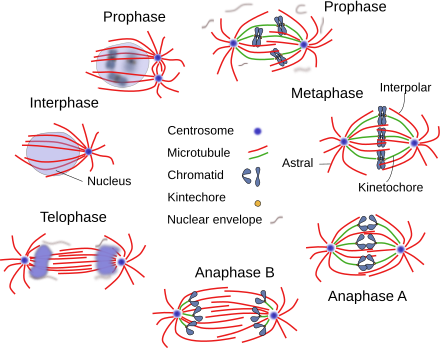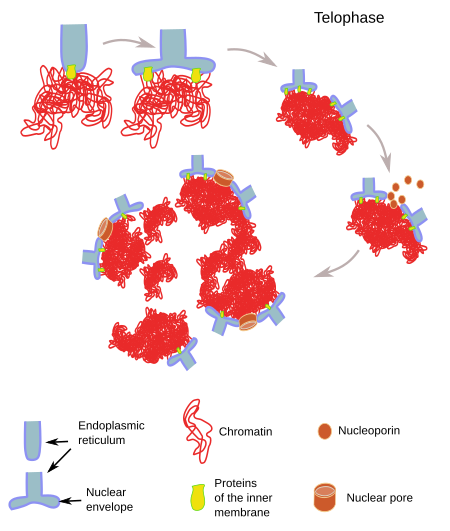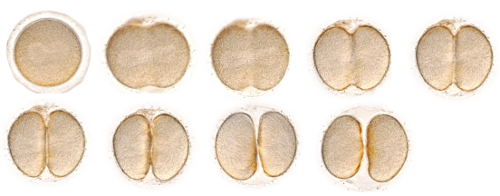1. Mitosis
- Prophase
- Metaphase
- Anaphase
- Telophase
2. Cytokinesis
The division of the cell in two daughter cells happens during the M phase. It consists of different processes running at the same time that end up with the division of the cellular components to form the two new cells. The components are synthesized in previous cell cycle phases and are divided between the two daughter cells. The components are the DNA, replicated during the S phase, and cytoplasmic organelles and molecules, synthesized during the G1, S, and G2 phases. The M phase is commonly divided into mitosis and cytokinesis.
During mitosis, the chromosomes are segregated between the two new cells, and the processes happening are related to what happened with chromatin: condensation, formation, segregation and decondensation of chromosomes. Cytokinesis is the split of the cytoplasm of the mother cell that leads to two independent cells. In animal cells, cytoplasm division is done by strangling, whereas in plant cells it is done by synthesizing a new cell wall. The plasma membrane undergoes a process of fusion and fission. Although most processes described below deal with chromatin and plasma membrane, the remaining cell content, such as molecules and organelles, including the Golgi apparatus and endoplasmic reticulum, has to be properly divided between the two new cells too.
1. Mitosis
Mitosis is a drastic change in the cell, which has to form a molecular machinery for separating the chromosomes: the mitotic spindle. The animal cell mitotic spindle has two poles where centrosomes are located, while plant cells lack centrosomes but form a mitotic spindle. There are two types of mitosis: open and closed. Open mitosis involves the nuclear envelope disorganization and spindle formation in the cytoplasm-nucleoplasm space. Closed mitosis keeps the integrity of the nuclear envelope, and the mitotic spindle is intranuclear. In closed mitosis, cell division means the strangling of the nucleus, as well as the cytoplasm, so the cytoplasm and nucleoplasm are always separated by the nuclear envelope. Some species show an intermediate type of mitosis, with the nuclear envelope having breakages. Other species may build cytoplasmic mitotic spindles, keeping the nuclear intact. Plant and animal cells perform open mitosis.
Prophase
The prophase is the first phase of mitosis, and it starts with DNA condensation so much that chromatids can be observed at light microscopy. The nucleolus disappears at the beginning of the prophase. Phosphorylation of histones, proteins of the chromatin, triggers DNA condensation. There are also changes going on in the cytoplasm. For example, cytoskeleton filaments undergo organizational changes, and cell adhesion is almost lost so that mitotic cells become rounded. This cellular shape is a feature of cells entering mitosis. In animal cells, the centrosome is duplicated at the end of the S phase. Initially, the two centrosomes remain together, but they are headed toward opposite sites in the cytoplasm at the beginning of prophase, moved by motor proteins associated with microtubules. After that, centrosomes start polymerizing microtubules with high dynamic instability (alternating between growing and shortening). Later, these microtubules form the mitotic spindle (Figure 1). In animal cells, organulles like the endoplasmic reticulum and Golgi complex are broken into small pieces, and the vesicular traffic is much less intense. The nuclear envelope is still present.

Some authors propose a further phase,named as prometaphase, after prophase. The nuclear envelope disorganizes during prometaphase, and it is broken into small pieces resembling vesicles. This process is initiated by the phosphorylation of the lamina proteins that form the nuclear lamina. In this way, microtubules can access chromatin, which continues the compaction process to become chromosomes. Microtubule plus ends make contact with kinetochores, which are structures located at the centromeres of chromosomes. Each chromosome bears two centromeres. Microtubules contacting the kinetochores are known as kinetochore microtubules. Each chromosome has two kinetochores at opposite locations, so that one kinetochore is contacted by microtubules polymerized in one centrosome, and the other kinetochore by microtubules coming from the other centrosome. Thus, every chromosome is linked by microtubules coming from both centrosomes. The number of microtubules converging in one kinetochore is variable, from 20 to 40 in humans, whereas it is only one in yeasts. Other microtubules coming from the two centrosomes do not contact chromosomes, but interact with each other by their plus ends. These interactions make them more stable by decreasing the dynamic instability at the plus end. These microtubules are known as interpolar microtubules. Finally, there are microbules nucleating from centrosomes toward the plasma membrane, known as astral microtubules. In some species, such as some amphibians, the number of microtubules forming the mitotic spindle may be thousands. In the endosperm of the angiosperm seeds, there are many microtubules that are non connected to the poles but only to chromosomes.
Metaphase
At the end of the prophase (or prometaphase), sister chromatids join to form chromosomes, and kinetochore microtubules contact kinetochores. Chromosomes are moved to the center of the mitotic spindle by kinetochore microtubules, at a place equidistant from the two spindle poles (centrosomes in animal cells), forming the so-called metaphase plate. Chromosomes are moved by increasing and decreasing the length of the kinetochore microtubules, as well as by the traction forces of microtubule associated motor proteins. When all chromosomes are positioned and lined up at the metaphase plate, we have the typical metaphase figure. When chromosomes are lining up at the metaphase plate, they can temporarily exit the metaphase plate and enter again. This is indicative of the ongoing pull and push forces produced by the kinetochore microtubules, since every chromosome is contacted by microtubules coming from both spindle poles.
Linking the kinetochore microtubules to chromosome kinetochores requires time. If there are not enough microtubules contacting each chromosome, an unequal segregation of chromosomes may happen, which leads to aneuploidy (the daughter cells contain more or less chromosomes than they should). A wrong set of chromosomes may lead to cell death or to a misbehaving and dangerous cell. To prevent aneuploidy, a checkpoint is working during metaphase, during the formation of the metaphase plate. When a kinetochore is contacted by fewer microtubules than needed, a signal is sent that prevents the separation of the chromatids in each chromosome and, therefore, the starting of the anaphase.
Anaphase
Anaphase starts with the split of each chromosome into the two sister chromatids. The breakage of the chromatids attachment happens at the centromere and allows sister chromatids to be dragged apart by microtubules toward the opposite spindle poles. The dragging speed is about 1 µm/min. There are two stages: anaphase A, when kinetochore microtubules depolymerize at both minus and plus ends, so they shorten and chromatids are dragged; anaphase B, when interpolar microtubules polymerize and increase in length, so they push the spindle poles in opposite directions, and the chromatids are also separated further. Motor proteins associated with the plus ends of the interpolar microtubules provide the dragging force to move away from the spindle poles by sliding one interpolar microtubule coming from one spindle pole over another microtubule coming from the other spindle pole. Other motor proteins associated with the astral microtubules drag centrosomes toward the surface of the cell, increasing the distance between sister chromatids.
Telophase
During telophase, nuclear envelopes are assembled around the two groups of chromatids (Figure 2), which have been dragged toward the two spindle poles. Then, two nuclei are formed. Phosphorylation of laminas, proteins of the nuclear lamina, initiates this process. Nuclear pores are also assembled, and the uncoiling of chromatids begins. Previously, microtubules were released from kinetochores.

2. Cytokinesis
Cytokinesis is the last stage of the cell cycle. During cytokinesis, the cytoplasm is divided to give rise to two new independent cells. This division takes place after the chromatids have been pulled apart. Otherwise ploidies may happen. Cytokinesis is different in animal, plant and fungus cells. However, they all follow some similar steps: choosing the orientation of the division plane, assembling the division molecular machinery, and dividing the cytoplasm.
In animal cells, the division plane is set by the orientation of the mitotic spindle, and the first evidence of the beginning of cytokinesis is a furrow, known as the division furrow, at the plasma membrane (Figure 3). The division furrow is perpendicular to the mitotic spindle, positioned at the equatorial position (at the same distance from the two centrosomes). However, in some cells, the position of the division furrow is displaced from the equator of the mitotic spindle, which results into two unequal cells, one larger than the other. This type of division is known as an asymmetrical division. The interactions between actin filaments and myosin motor proteins produces the division furrow during the final part of the anaphase. Actin filaments slide over one another, pulled by myosin molecules assembling the division ring, which decreases in diameter and strangles the cytoplasm until the ring gets completely closed. The contractile ring is transient and disappears after the division is completed. Before that, the spindle microtubules trapped by the ring must be removed. Furthermore, the opening and sealing of cell membranes that gives rise to two independent cells is a complex process. In both animal and plant cells, it has been observed that organelles involved in the vesicular traffic are needed during the final part of cytokinesis. They provide more membrane for the new plasma membranes and the protein machinery to deal with breakage and fusion of the membranes, processes that are similar to those happening in vesicular trafficking.

In plant and fungus cells, cytokinesis is different because of the cell wall. The two new cells are not separated by a ring of actin filaments. Instead, a new cell wall is formed in the interior of the progenitor cell that divides the cytoplasm into two parts (Figure 4). In plants, the first evidence of this new cell wall formation is the phragmoplast. Phragmoplast is a complex structure composed of some microtubules from the mitotic spindle and vesicles delivered by the Golgi apparatus. Vesicles coming from the Golgi apparatus are moved to this central area by microtubules and motor associated proteins. Vesicles fuse to each other and start to form the cell membranes of the new cells, whereas their content forms the cell plate and later the new cell wall. In plants, the cell wall grows centrifugally, i.e., from the inner part of the cell toward the periphery. In fungus cells, which have no phragmoplast, it is the other way around. The more external components, the more recently synthesized. A division furrow is not observed in plant cells, but it is present in fungus cells. In plants and fungi, the orientation and position of the division plane are established under the influence of the nucleus during the late G2 phase. Microtubule bundles are oriented around the cell nucleus before the beginning of the M phase, and this scaffold, known as the preprophase band (PPB), leaves a trace in the cortical cytoplasm. The bundle of microtubules around the nucleus disappears at the beginning of mitosis, but the modifications they made in the cortical cytoplasm affect the formation of the phragmoplast and the division plane.

-
Bibliography ↷
-
Bibliography
Pardo M. 2005. Citoquinesis en células eucariotas. Investigación y ciencia 346:40-49.
Wanke C, Kutay Uz. 2013. Enclosing chromatin: reassembly of the nucleus after open mitosis. Cell 152: 1222-1225.
-
 G2 phase
G2 phase